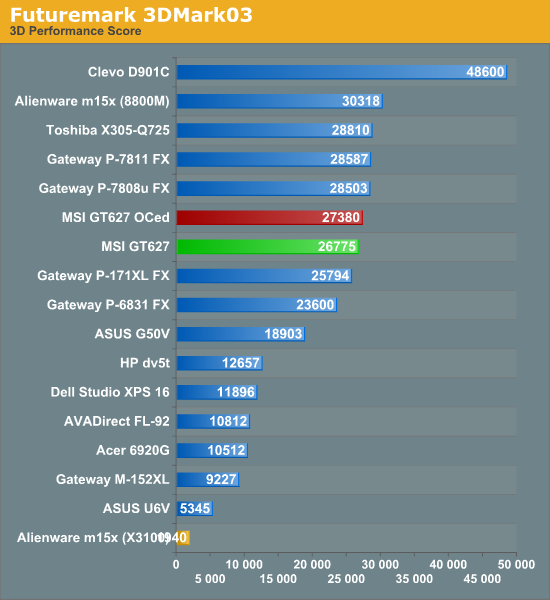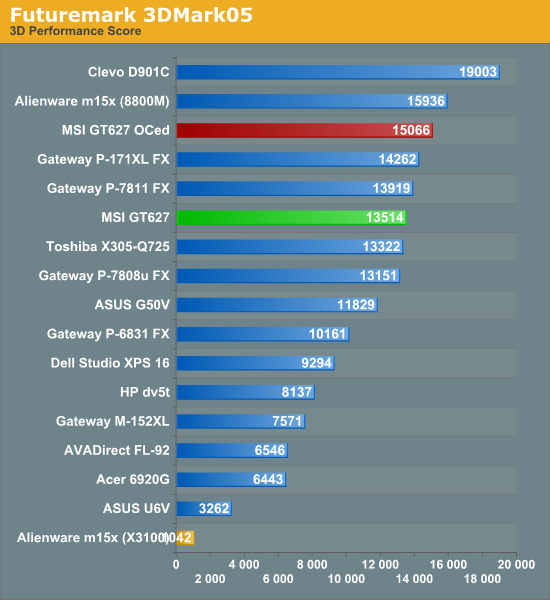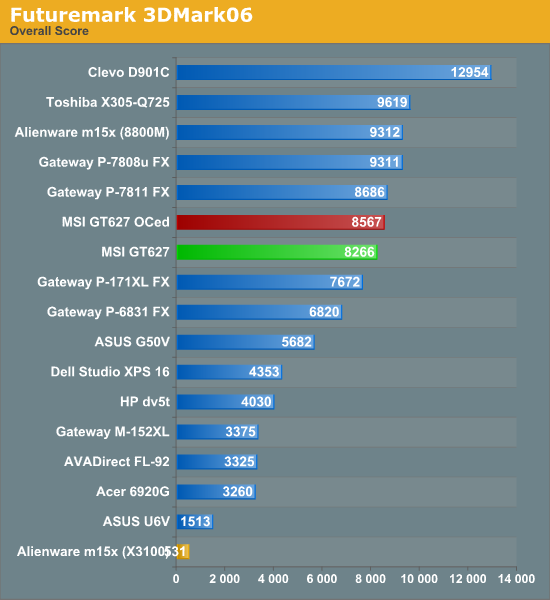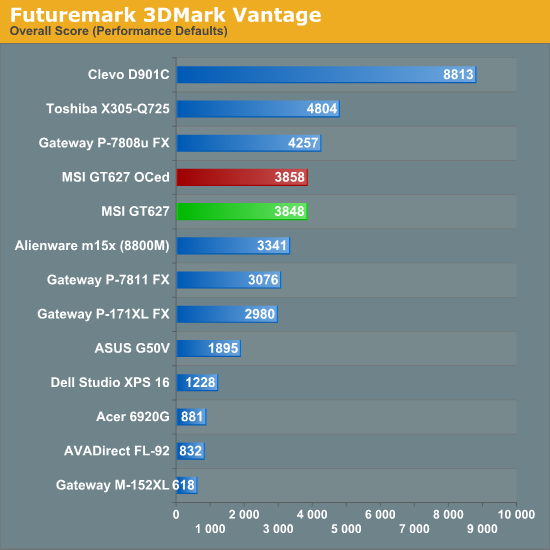MSI GT627: Bringing Balance to the Force?
by Jarred Walton on April 29, 2009 4:00 AM EST- Posted in
- Laptops
Synthetic Gaming: 3DMark Results
Next, we ran the ubiquitous 3DMark benchmarks from Futuremark. Performance in these tools mirrors some game engines, but ultimately they are a measure of 3DMark performance and not of games. We would place more weight on the previous page, but these utilities do provide an easy way of comparing systems if you don't want to get bogged down in details. In order to make the comparisons valid, we run all 3DMark tests at the standard resolution: 1024x768 for 03/05 and 1280x1024 for 06/Vantage. With laptops like the MSI GT627 that are unable to support the necessary resolution 1280x1024 resolution, we connect an external LCD.
Note that we colored the Alienware m15x gold for tests conducted utilizing the integrated X3100 graphics instead of the discrete 8800M GTX. We will follow that pattern on the battery life tests, where we can see the true benefits of being able to switch off the discrete graphics and run on an IGP solution. Considering the discrete GPUs run at significantly slower speeds on battery power, there's very little point in having them chew up battery life in most cases.




Driver updates have not had as much of an impact on 3DMark performance, so in terms of strict 3DMark03/05 performance the MSI GT627 doesn't do as well. However, 3DMark levels the playing field by running at a set resolution, which in many cases doesn't reflect the way most people play games on a laptop. For example, if you own a 17" laptop with a WUXGA LCD, it's highly unlikely you will be running any games at 1280x1024. The GT627 isn't the fastest gaming notebook available, but it provides good performance balanced against features, and it does so at an attractive price point. Overclocking helps in the earlier 3DMark titles, but it doesn't help as much in the more GPU limited 3DMark06/Vantage. It's interesting to note that Vantage still shows a significant CPU performance increase, but that doesn't influence the score nearly as much as the relatively static 3D performance










47 Comments
View All Comments
fwacct4 - Saturday, May 2, 2009 - link
I'm glad noise has been evaluated in this laptop review as well. Lots of stuff on desktop noise, but since I can't stick a laptop in a closet and still run it, fan noise on a laptop distracts me like nothing else. Even worse are laptop fan noise coming from people sitting near me.Rolling Camel - Friday, May 1, 2009 - link
I'm really looking forward to a GT725, it is the uber notebook below $2000, not Gateway. My A64 3000+ is really slow and i need a computer with enough graphics power. So either i get an Phenom 2 X3 and Hd4870 based system, or get the GT725. The desktop is cheaper and more powerful, but i need mobility for my school.I know the GT725 has some worries:
1.The keyboard, although there is a solution for it.
2.Many report that the track pad wears fast, as if i will ever use.
3.I'm worried about the thermal dissipation. The R770 seems more fit for the task.
4.Warranty and customer service.
The HD4670 equipped EX 625 is very tempting with it's $750 price tag.
ira176 - Friday, May 1, 2009 - link
Apple's batteries are custom made lithium polymer. They are not typical run of the mill lithium ion cells that most manufacturers use. Apple's batteries use all of the space in their design and have no "dead" space due to round cells packed in a rectangular battery as most win pc notebooks have. Although Apple's OS may be a little more conservative on battery usage it's got to be the mere fact that there's more capacity in their battery design, and maybe even cherry picked hardware and LED lcd displays. Win pc's could probably see better battery life with better battery designs and better part choices. Of course we would pay more for that pc notebook.JarredWalton - Friday, May 1, 2009 - link
Apples batteries are rated at between 40 Whr and 50 Whr in the current models - 40 for the Air, 45 for the standard MacBook, and 50 for the Pro if I'm not mistaken. The construction and material used in a battery does not affect the rating in Whr. If something is designed to output 5200 mA at 9.6V, it is a 50 Whr battery. A lithium polymer might be lighter for the total capacity, but I'm not talking about capacity.Given the above, it means that Apple's standard MacBook apparently consumes around 9.4W when surfing the Internet. In contrast, the ASUS U6V eats up 21W on average for the same task. I'm hoping to get a MacBook for a bit just to make sure there's nothing else going on, but Apple apparently uses less power surfing than most Vista PCs use at idle.
Zan Lynx - Friday, May 1, 2009 - link
From what I've gathered about it, Apple "cheats." They can turn hardware on and off and do clock scaling that isn't available via ACPI.JarredWalton - Friday, May 1, 2009 - link
Lenovo indicated to me at CES that they actually turn off components that aren't in use, which is how they improve battery life (supposedly - still waiting for a test sample). It makes sense that if your optical drive is inactive, completely shutting off power makes more sense than a .5W sleep state. They said they also power off the speakers when the sound is muted or when headphones are connected (another few hundred mW). I don't know about other devices, but really I don't care if it's "cheating" - custom designed hardware that functions better than the competition is fine as long as it works properly. Windows 7 is supposed to enable some better power savings (up to 11% better battery life I've heard), so we'll see.The0ne - Thursday, April 30, 2009 - link
If you're going to game on it why not just get one with 17" LCD? Better yet, get one with 1900x1200 and everything is just beautiful :)It's great that the article addresses the LCD issues. I mean come on, it's one of the main components when considering a laptop.
Rob94hawk - Thursday, April 30, 2009 - link
Where is this Clevo901c laptop?JarredWalton - Thursday, April 30, 2009 - link
I'm not sure what you mean. Do you mean where are the specs? If that's your question, the Sager NP9262 is a Clevo D901C chassis. Several other companies (WidowPC, AVADirect, Eurocom, etc.) use the Clevo chassis and rebrand it as their own, so I figured listing the original manufacturer in that case made the most sense.GoatMonkey - Wednesday, April 29, 2009 - link
The display on the MSI GT627 218US is apparently different, because it is listing max resolution of 1680x1050. I'd like to know if that display has better contrast ratio.Also, any news on the upcoming MSI GT628 with the nVidia M160?